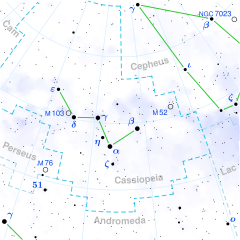S Cassiopeiae
| Observation data Epoch J2000 Equinox J2000 | |
|---|---|
| Constellation | Cassiopeia |
| Right ascension | 01h 19m 41.99s[1] |
| Declination | 72° 36′ 40.8″[1] |
| Apparent magnitude (V) | +7.9 – +16.1[2] |
| Characteristics | |
| Spectral type | S3,4 – S5,8[3] |
| Variable type | Mira[2] |
| Astrometry | |
| Proper motion (μ) | RA: 3.201[4] mas/yr Dec.: 1.056[4] mas/yr |
| Parallax (π) | 1.0515 ± 0.0907 mas[5] |
| Distance | 3,100 ± 300 ly (950 ± 80 pc) |
| Details | |
| Radius | 930[6] R☉ |
| Luminosity | 5,210[7] L☉ |
| Temperature | 1,800[8] K |
| Other designations | |
| Database references | |
| SIMBAD | data |
S Cassiopeiae (S Cas, HD 7769) is a Mira variable and S-type star in the constellation Cassiopeia. It is an unusually cool star, rapidly losing mass and surrounded by dense gas and dust producing masers.
Distance
[edit]In the absence of a measurement of its parallax by the Hipparcos satellite, its distance from the Solar System was estimated between 1,860 and 2,770 light-years.[8][9] Gaia Data Release 2 published a parallax of 0.8585±0.1626 mas, indicating a distance around 1200 pc,[4] but the observations have a very high noise level and are considered unreliable. A distance of 460 pc is preferred.[7]
Spectral type
[edit]With a spectral type of S3,4e-S5,8e, S Cassiopeiae is an S-type star similar to χ Cygni; these are asymptotic giant branch (AGB) stars similar to those of class M except that the dominant spectral bands of metal oxides are formed by metals of the fifth period of the periodic table as zirconium or yttrium. Another feature of this class of stars is the high mass loss; in the case of S Cassiopeiae it is estimated at 1.8×10−6 M☉ per year.[7]
Characteristics
[edit]S Cassiopeiae has a radius of 934 solar radii; if placed at the center of the Solar System, it would extend past the orbit of Mars and the Asteroid Belt. Its effective temperature is 1,800 K,[8] which is possibly a late thermal pulse asymptotic giant branch red giant star near the tip of its evolution, after this, it may enter its white dwarf phase after it sheds its outer layers or shrinks and gets hotter to a possibly orange giant. Its surface temperature is exceptionally cool for any star other than the brown dwarfs, and its bolometric luminosity is 5,210 times that of the sun.[7]

S Cassiopeiae is a variable Mira, a pulsating variable star whose visual brightness varies over several magnitudes with a somewhat regular period and amplitude. Its visual magnitude varies between +7.9 and +16.1 over an average period of 612.43 days. Mira variables are stars in the last stages of evolution whose instability comes from pulsations in their surfaces, causing changes in color and brightness. Some of them, including S Cassiopeiae show SiO maser emission.[11]
See also
[edit]References
[edit]- ^ a b Cutri, Roc M.; Skrutskie, Michael F.; Van Dyk, Schuyler D.; Beichman, Charles A.; Carpenter, John M.; Chester, Thomas; Cambresy, Laurent; Evans, Tracey E.; Fowler, John W.; Gizis, John E.; Howard, Elizabeth V.; Huchra, John P.; Jarrett, Thomas H.; Kopan, Eugene L.; Kirkpatrick, J. Davy; Light, Robert M.; Marsh, Kenneth A.; McCallon, Howard L.; Schneider, Stephen E.; Stiening, Rae; Sykes, Matthew J.; Weinberg, Martin D.; Wheaton, William A.; Wheelock, Sherry L.; Zacarias, N. (2003). "VizieR Online Data Catalog: 2MASS All-Sky Catalog of Point Sources (Cutri+ 2003)". CDS/ADC Collection of Electronic Catalogues. 2246: II/246. Bibcode:2003yCat.2246....0C.
- ^ a b Samus, N. N.; Durlevich, O. V.; et al. (2009). "VizieR Online Data Catalog: General Catalogue of Variable Stars (Samus+ 2007-2013)". VizieR On-line Data Catalog: B/GCVS. Originally Published in: 2009yCat....102025S. 1. Bibcode:2009yCat....102025S.
- ^ Ramstedt, S.; Schöier, F. L.; Olofsson, H.; Lundgren, A. A. (2006). "Mass-loss properties of S-stars on the AGB". Astronomy and Astrophysics. 454 (2): L103. arXiv:astro-ph/0605664. Bibcode:2006A&A...454L.103R. doi:10.1051/0004-6361:20065285. S2CID 119080381.
- ^ a b c Brown, A. G. A.; et al. (Gaia collaboration) (August 2018). "Gaia Data Release 2: Summary of the contents and survey properties". Astronomy & Astrophysics. 616. A1. arXiv:1804.09365. Bibcode:2018A&A...616A...1G. doi:10.1051/0004-6361/201833051. Gaia DR2 record for this source at VizieR.
- ^ Brown, A. G. A.; et al. (Gaia collaboration) (2021). "Gaia Early Data Release 3: Summary of the contents and survey properties". Astronomy & Astrophysics. 649: A1. arXiv:2012.01533. Bibcode:2021A&A...649A...1G. doi:10.1051/0004-6361/202039657. S2CID 227254300. (Erratum: doi:10.1051/0004-6361/202039657e). Gaia EDR3 record for this source at VizieR.
- ^ Ramstedt, S.; Schöier, F. L.; Olofsson, H. (2009). "Circumstellar molecular line emission from S-type AGB stars: mass-loss rates and SiO abundances". Astronomy and Astrophysics. 499 (2): 515–527. arXiv:0903.1672. Bibcode:2009A&A...499..515R. doi:10.1051/0004-6361/200911730. S2CID 17942939. 515-527.
- ^ a b c d McDonald, I.; De Beck, E.; Zijlstra, A. A.; Lagadec, E. (2018). "Pulsation-triggered dust production by asymptotic giant branch stars". Monthly Notices of the Royal Astronomical Society. 481 (4): 4984. arXiv:1809.07965. Bibcode:2018MNRAS.481.4984M. doi:10.1093/mnras/sty2607. S2CID 118969263.
- ^ a b c Ramstedt, S.; Olofsson, H. (2014). "The 12CO/13CO ratio in AGB stars of different chemical type. Connection to the 12C/13C ratio and the evolution along the AGB". Astronomy & Astrophysics. 566: A145. arXiv:1405.6404. Bibcode:2014A&A...566A.145R. doi:10.1051/0004-6361/201423721. S2CID 59125036.
- ^ Guandalini, R.; Busso, M. (2008). "Infrared photometry and evolution of mass-losing AGB stars. II. Luminosity and colors of MS and S stars". Astronomy and Astrophysics. 488 (2): 675–684. arXiv:0806.4591. Bibcode:2008A&A...488..675G. doi:10.1051/0004-6361:200809932. S2CID 14294870.
- ^ "Download Data". aavso.org. AAVSO. Retrieved 1 October 2021.
- ^ Herpin, F.; Baudry, A.; Thum, C.; Morris, D.; Wiesemeyer, H. (2006). "Full polarization study of SiO masers at 86 GHz". Astronomy and Astrophysics. 450 (2): 667–680. arXiv:astro-ph/0601098. Bibcode:2006A&A...450..667H. doi:10.1051/0004-6361:20054255. S2CID 17330694.

